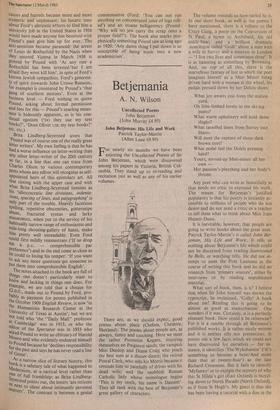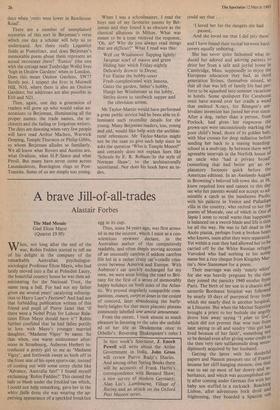Betjemania
A. N. Wilson
Uncollected Poems John Betjeman (John Murray £4.95) John Betjeman: His Life and Work Patrick Taylor-Martin (Allen Lane £9.95)
For nearly six months we have been enjoying the Uncollected Poems of Sir John Betjeman, which were discovered among his papers in Victoria, British Col- umbia. They stand up to re-reading and recitation just as well as any of his earlier volumes.
There are, as we should expect, good poems about place (Chelsea, Cheshire, Shetland). The poems about people are, as always, funny and touching. Here we meet the rather Pooterish Kegans, enjoying themselves on Paignton sands; the vampish Miss Dunlop and Diana Craig who pinch the best men at a dinner-dance; the retired Postal Clerk, who sells his Morris because it reminds him so painfully of drives with his dead wife; and the snobbish Roman Catholic lady whose monologue begins `This is my tenth, his name is Damien'. They all rank with the best of Betjeman's great gallery of characters.
The volume reminds us how varied he is. In one short book, as well as the poems I have mentioned, there is a tribute to the Crazy Gang, a poem on the Conversion of St Paul; a hymn to Archibald, his old teddy-bear; and a brilliant dramatic .monologue called 'Guilt' about a man with a wife in Surrey and a mistress in London — 'I live two lives and sometimes three'. It is as haunting as something by Browning. And, on top' of all this, there is the marvellous fantasy of lust in which the poet imagines himself as a Mini Minor being driven hard with a woman at the wheel, his pedals pressed down by her Dolcis shoes:
What joy awaits you from the station yard, Oh lithe-limbed lovely in the ski-ing pants?
What warm upholstery will hold those thighs?
What tasselled lanes from Surrey into Hants Will meet the rapture of those dark brown eyes?
What pedal feel the Dolcis pressing hard?
Yours, revved-up Mini-minor all her own - Her passion's plaything and her body's throne.
Any poet who can write as beautifully as that needs no critic to expound his work. The reason for Betjeman's justified popularity is that his poetry is instantly ac- cessible to millions of people who do not desire and do not need a critic or a teacher to tell them what to think about Miss Joan Hunter-Dunn.
It is inevitable, however, that people are going to write books about the great man. Patrick Taylor-Martin's is called John Bet- jeman, His Life and Work. It tells us nothing about Betjeman's life which could not be discerned from reading Summoned by Bells, or watching telly. He did not at- tempt to meet the Poet Laureate in the course of writing this book and he did no research from 'primary sources', either by interviews or by reading unpublished material.
What sort of book, then, is it? I believe that when Sir John himself was shown the typescript, he exclaimed, 'Golly! A book about me! Reading this is going to be almost as good as masturbation'. One wonders if it was. Certainly, it is a perfectly pleasant book. How could it be otherwise? For it is a ramble through all Betjeman's published works. It is rather nicely written and it is neither silly nor pretentious. It points out a few facts which we could not have discovered for ourselves — for in- stance, it identifies 'The Wykehamist' (' It's something to become a bore/And more than that at twenty-four') as the late Richard Crossman. But it fails to identify `Myfanwy' or to explain the mystery of why this St Hilda's girl (East Oxford) is bicycl- ing down to North Parade (North Oxford), as if from St Hugh's, My guess is that she has been having a tutorial with a don in the
days when 'rents were lower in Rawlinson Road'.
There are a number of unexplained mysteries of this sort in Betjeman's verse which one day a scholar will help us to understand. Are there really Liquorice fields at Pontefract, and does Betjeman's memorable poem about them represent an actual encounter there? 'Eunice' (the one with the cottage near Tunbridge Wells) lives `high in Onslow Gardens' when in London. Does this mean Onslow Gardens, SW7? Surely not. I suspect she lives in Muswell Hill, N10, where there is also an Onslow Gardens; but addresses are also possible in El 0 and N21.
Then, again, one day a generation of readers will grow up who would value an- notations to Betjeman, illuminating all the proper names: the trade names, the ar- chitects and the fading or forgotten writers. The days are dawning when very few people will have read Arthur Machen, Warwick Deeping, Temple Thurston or Philip Gibbs, to whom Betjeman alludes so familiarly. We all know what Rovers and Austins are, what Ovaltine, what H.P.Sauce and what Persil. But many have never come across Laundaulettes, Bravington rings or Post- Toasties. Some of us are simply too young.
When I was a schoolmaster, I read the boys one of my favourite poems by Bet- jeman and they found it as obscure as the classical allusions in Milton. What was meant to be a treat received the response, `Oh, sir! Why do you always read things that are difficult?' What I read was this:
Well cut Windsmoor flapping lightly: Jacqmar scarf of mauve and green Hiding hair which Friday-nightly Delicately drowns in Drene; Fair Elaine the bobby-soxer Fresh-complexioned with Innoxa, Gains the garden, father's hobby, Hangs her Windsmoor in the lobby, Settles down to sandwich supper and the television screen.
Mr Taylor-Martin would have performed a great public service had he been able to il- luminate such recondite details for the young. Many Betjeman readers, too, young and old, would like help with the architec- tural references. Mr Taylor-Martin might not be the man to give such help since he asks the question 'Who is Temple Moore?' and certainly does not explain lines like `Schools by E. R. Robson/In the style of Norman Shaw'; to the architecturally uninitiated. Nor does his book have an in- dex.











































 Previous page
Previous page